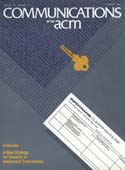October 1985 - Vol. 28 No. 10

Features
Security without identification: transaction systems to make big brother obsolete
The large-scale automated transaction systems of the near future can be designed to protect the privacy and maintain the security of both individuals and organizations.
DSS design: a systemic view of decision support
A systemic view of DSS can provide a concrete framework for effective design of DSS and can also serve as a basis for accumulating DSS research results.
Orthogonal Latin squares: an application of experiment design to compiler testing
Orthogonal Latin squares—a new method for testing compilers—yields the informational equivalent of exhaustive testing at a fraction of the cost. The method has been used successfully in designing some of the tests in the Ada Compiler Validation Capability (ACVC) test suite.
Systems programming with JSP: example—a VDU controller
The generation of an embedded microprogram controlling a video display unit demonstrates how Jackson Structured Programming can be used effectively for both systems programming and microprocessor applications.
A probability model for overflow sufficiency in small hash tables
For hash tables in which a strict physical separation exists between primary storage and storage for overflow records, with bucket capacity at least three, a complete probability model is described. A measure of hash table efficiency is introduced, called the table sufficiency index (TSI), and defined as the probability that the overflow space is sufficient assuming that the set of hashed keys has a uniform distribution. The constructed probability model may be used to compute the TSI for hash tables with parameters chosen from a restricted domain. The TSI is advocated as a tool for making decisions about the parameters of small hash tables.
The P2 algorithm for dynamic calculation of quantiles and histograms without storing observations
A heuristic algorithm is proposed for dynamic calculation of the median and other quantiles. The estimates are produced dynamically as the observations are generated. The observations are not stored; therefore, the algorithm has a very small and fixed storage requirement regardless of the number of observations. This makes it ideal for implementing in a quantile chip that can be used in industrial controllers and recorders. The algorithm is further extended to histogram plotting. The accuracy of the algorithm is analyzed.



